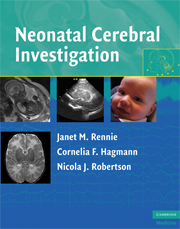Book contents
- Frontmatter
- Contents
- List of contributors
- Preface
- Acknowledgements
- Glossary and abbreviations
- Section I Physics, safety, and patient handling
- Section II Normal appearances
- Section III Solving clinical problems and interpretation of test results
- 7 The baby with a suspected seizure
- 8 The baby who was depressed at birth
- 9 The baby who had an ultrasound as part of a preterm screening protocol
- 10 Common maternal and neonatal conditions that may lead to neonatal brain imaging abnormalities
- 11 The baby with an enlarging head or ventriculomegaly
- 12 The baby with an abnormal antenatal scan: congenital malformations
- 13 The baby with a suspected infection
- 14 Postmortem imaging
- Index
- References
10 - Common maternal and neonatal conditions that may lead to neonatal brain imaging abnormalities
from Section III - Solving clinical problems and interpretation of test results
Published online by Cambridge University Press: 07 December 2009
- Frontmatter
- Contents
- List of contributors
- Preface
- Acknowledgements
- Glossary and abbreviations
- Section I Physics, safety, and patient handling
- Section II Normal appearances
- Section III Solving clinical problems and interpretation of test results
- 7 The baby with a suspected seizure
- 8 The baby who was depressed at birth
- 9 The baby who had an ultrasound as part of a preterm screening protocol
- 10 Common maternal and neonatal conditions that may lead to neonatal brain imaging abnormalities
- 11 The baby with an enlarging head or ventriculomegaly
- 12 The baby with an abnormal antenatal scan: congenital malformations
- 13 The baby with a suspected infection
- 14 Postmortem imaging
- Index
- References
Summary
Introduction
The superb anatomical detail, gray–white matter differentiation, subtle volume differences, and metabolic information available from magnetic resonance studies of the newborn brain have revolutionized our understanding of the trajectory of normal development and the effect of prenatal and postnatal factors. It is increasingly recognized that an adverse prenatal or postnatal environment can have profound effects on the normal course of brain development, leading to long-term consequences in brain structure, behavior, cognition, and neurology.
This chapter is divided into three sections. The first section describes two common maternal conditions that may lead to neonatal cerebral injury. Being a twin, for example, may influence the trajectory of brain development merely by the sharing of a placenta and the effect of common placental anastomoses on the brain. Substance or alcohol abuse, an increasing problem in western countries, influences brain development in subtle ways; there has been much interest recently in the way that environmental influences acting during early development shape risk in later life. This is termed epigenetics and refers to the system of inheritance that does not involve changes in the primary DNA sequence but which can nevertheless be transmitted through cell lineages and can result in altered gene expression (for review see [1]). In the current era where brain magnetic resonance imaging (MRI) is possible in infants at risk, we are able to study the phenotypes of certain environmental influences.
- Type
- Chapter
- Information
- Neonatal Cerebral Investigation , pp. 210 - 234Publisher: Cambridge University PressPrint publication year: 2008

